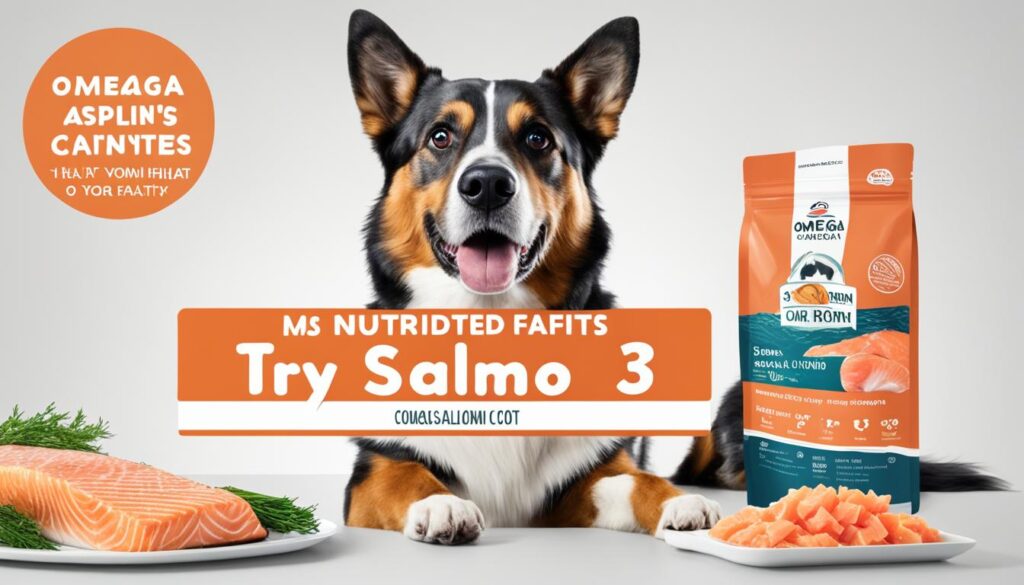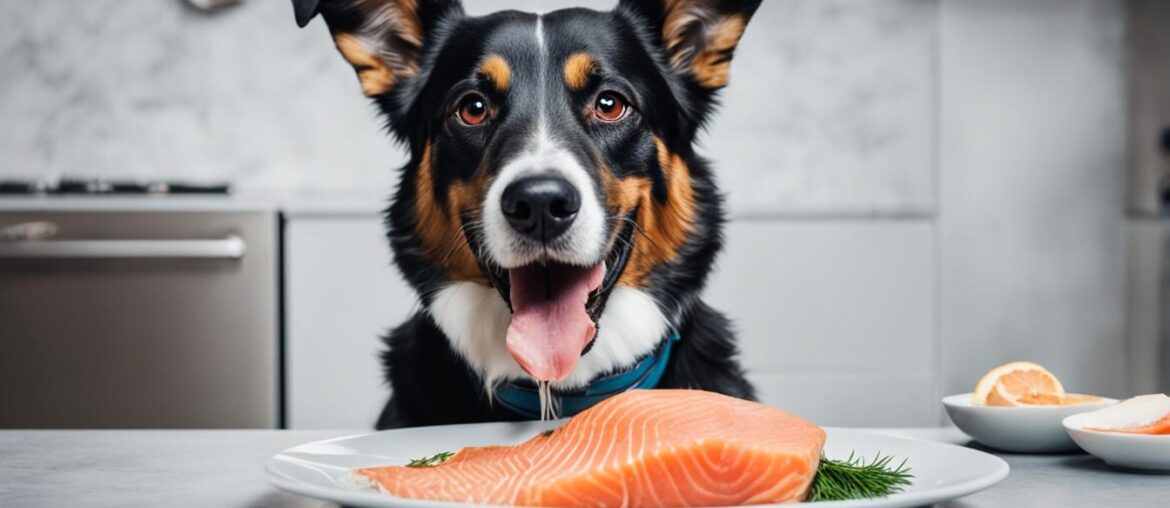As a dog owner, you may be curious about what foods are safe and suitable for your furry friend. One particular question that often arises is whether dogs can safely consume smoked salmon. While this delicacy may be a delectable treat for humans, it’s crucial to understand the potential risks and benefits it poses to our four-legged companions.
Feeding smoked salmon to dogs can be risky due to its high salt content. The excessive intake of salt can lead to sodium ion poisoning in dogs, causing symptoms such as vomiting, diarrhea, and even seizures. Moreover, smoked salmon and raw fish may harbor harmful bacteria that can cause serious health issues in dogs.
However, not all hope is lost when it comes to including salmon in your dog’s diet. Cooked salmon, devoid of seasonings or spices, can be a nutritious addition to their meals. It contains omega-3 fatty acids, which promote healthy muscles and joints, support a shiny coat, and contribute to overall well-being.
Key Takeaways:
- Feeding smoked salmon to dogs is not recommended due to its high salt content that may cause sodium ion poisoning.
- Raw fish and smoked salmon can carry harmful bacteria that pose health risks for dogs.
- Cooked salmon, without any seasonings, can be beneficial for dogs, providing essential omega-3 fatty acids and other nutrients.
- Consult with your veterinarian for dietary guidance and to ensure your dog’s safety and well-being.
- Ensure moderation and portion control when incorporating salmon into your dog’s diet.
Why Smoked Salmon can be Harmful to Dogs
Smoked salmon is a popular delicacy among humans, but it poses several dangers for our canine companions. While dogs may enjoy the taste of smoked salmon, it is essential to understand the risks associated with feeding it to them.
One of the main concerns with smoked salmon is its high salt content. The curing and smoking process introduces excessive amounts of salt, which can be harmful to dogs if consumed in large quantities. The excessive salt intake can lead to a condition called sodium ion poisoning, also known as salt poisoning or salt toxicity. This condition occurs when dogs ingest more salt than their bodies can handle, causing an imbalance in their electrolytes and leading to various health issues.
Sodium ion poisoning can cause dogs to experience symptoms such as vomiting, diarrhea, excessive thirst, dehydration, lethargy, tremors, seizures, and even death in severe cases. The high salt content in smoked salmon exacerbates these risks, making it a dangerous food choice for dogs.
Additionally, smoked salmon and raw fish can carry harmful bacteria such as Salmonella or listeria, which can pose serious health problems for dogs. These bacteria can cause gastrointestinal issues, including diarrhea, vomiting, and abdominal pain. In some cases, they may lead to more severe complications that require veterinary intervention.
The risks of raw fish for dogs
Feeding dogs raw fish, including smoked salmon, can also expose them to certain parasites. Parasitic infections, such as tapeworms or roundworms, can compromise a dog’s health and require medical treatment.
| Dangers of Smoked Salmon for Dogs | Sodium Ion Poisoning | Risks of Raw Fish |
|---|---|---|
|
|
|
Given these risks, it is crucial to prioritize the health and well-being of our furry friends by avoiding smoked salmon and raw fish in their diets. Instead, opt for cooked salmon, which can be a nutritious addition to their meals when prepared properly.
By understanding the dangers posed by smoked salmon and taking appropriate precautions, we can ensure that our beloved pets stay healthy and safe.
Nutritional Benefits of Cooked Salmon for Dogs

Cooked salmon offers a range of nutritional benefits for dogs, making it a valuable addition to their diet. Salmon is packed with essential nutrients that promote overall health and well-being. Let’s explore the health benefits of cooked salmon for dogs:
1. Omega-3 Fatty Acids for Dogs
Salmon is an excellent source of omega-3 fatty acids, such as EPA and DHA, which are essential for dogs. These fatty acids have numerous health benefits, including:
- Supporting healthy muscle development and growth.
- Reducing inflammation and promoting joint health.
- Improving cognitive function and supporting brain health.
- Promoting a shiny, lustrous coat and healthy skin.
Omega-3 fatty acids are crucial for maintaining your dog’s overall well-being and can contribute to their overall vitality.
2. Vitamins and Minerals in Salmon
Salmon is also rich in essential vitamins and minerals that are beneficial for dogs. Some of the key nutrients found in salmon include:
- Vitamin A: Supports a healthy immune system and vision.
- Vitamin B: Promotes energy production, aids in digestion, and supports a healthy metabolism.
- Vitamin D: Helps with calcium absorption for strong bones and teeth.
- Potassium: Plays a vital role in maintaining proper hydration, nerve function, and muscle contractions.
- Selenium: Acts as an antioxidant, supports thyroid function, and helps maintain a healthy immune system.
By including cooked salmon in your dog’s diet, you can provide them with a nutritious source of vitamins and minerals that contribute to their overall health and vitality.
It’s important to note that while cooked salmon provides numerous health benefits for dogs, moderation is key. Excessive consumption can lead to an imbalance in their diet. Always consult with your veterinarian before making any changes to your dog’s diet to ensure it aligns with their specific nutritional needs.
Precautions when Feeding Dogs Salmon

When it comes to feeding dogs salmon, it’s essential to take precautions to ensure their safety and well-being. Here are some important points to consider:
1. Safe Ways to Feed Dogs Salmon
When offering salmon to your canine companion, it’s crucial to follow these safe feeding practices:
- Choose unseasoned and plain salmon to avoid exposing dogs to harmful spices and seasonings.
- Cook the salmon thoroughly to kill any potentially harmful bacteria and parasites.
- Remove bones from the salmon before feeding it to your dog to prevent choking hazards.
2. Risks of Feeding Seasoned Salmon to Dogs
Seasoned salmon may contain ingredients that are unsafe for dogs. The added spices, herbs, and seasonings can irritate a dog’s digestive system and potentially cause adverse reactions. It’s best to avoid feeding dogs seasoned salmon to prevent any gastrointestinal discomfort or other health issues.
3. Dangers of Salmon Bones for Dogs
Bones, especially small fish bones, can pose a significant risk to dogs. They can splinter easily and cause choking, blockages, or internal injuries. Always remove any bones from the salmon before offering it to your canine companion to ensure their safety and prevent potential emergencies.
By following these precautions, you can safely incorporate salmon into your dog’s diet and provide them with a nutritious and enjoyable treat. Remember to consult with your veterinarian for specific dietary recommendations and portion sizes tailored to your dog’s individual needs.
Can Dogs Eat Salmon Skin?

When it comes to feeding dogs, the question often arises: can dogs eat salmon skin? The answer is yes, but there are some important considerations to keep in mind. Salmon skin can be a nutritious addition to a dog’s diet, providing various benefits. However, it should only be served cooked, plain, and in small portions. Let’s explore the benefits of salmon skin for dogs and the precautions that need to be taken.
Benefits of Salmon Skin for Dogs
Salmon skin is rich in omega-3 fatty acids, which are essential for a dog’s overall health. Omega-3 fatty acids promote healthy skin and coat, reduce inflammation, and support cognitive function in dogs. Additionally, salmon skin contains important vitamins and minerals, such as vitamin D and selenium, which contribute to the overall well-being of your furry friend.
“The omega-3 fatty acids found in salmon skin promote healthy skin and coat, reduce inflammation, and support cognitive function in dogs.”
Precautions when Feeding Salmon Skin to Dogs
While there are benefits to feeding salmon skin to dogs, precautions must be taken to ensure their safety. The main concern with salmon skin is its high-fat content, which can lead to weight gain if consumed in large quantities. Therefore, it is essential to serve salmon skin sparingly as a treat rather than a regular part of their diet.
Furthermore, it is important to use fresh salmon skin rather than canned salmon, as fresh salmon provides higher nutritional value. Canned salmon may contain added seasonings or preservatives that can be harmful to dogs.
Nutritional Comparison of Salmon Skin and Flesh
| Nutrient | Salmon Skin | Salmon Flesh |
|---|---|---|
| Omega-3 Fatty Acids | High | High |
| Protein | Lower | Higher |
| Fat Content | High | Lower |
| Vitamins and Minerals | Varied | Varied |
Note: The nutritional values can vary depending on the specific type and quality of salmon.
Remember, before introducing any new food to your dog’s diet, it is always best to consult with your veterinarian. They can provide guidance on portion sizes, potential allergies, and any specific dietary considerations for your dog’s overall health.
Moderation and Portion Control for Feeding Dogs Salmon

When it comes to feeding dogs salmon, moderation and portion control are key to ensure their health and well-being. While salmon can be a nutritious addition to a dog’s diet, it should be offered in small portions as a treat rather than a main meal.
The recommended portion size for dogs depends on their size and weight. As a general guideline, dogs should be fed an appropriate portion of salmon based on their individual needs and dietary requirements. It is best to consult with a veterinarian to determine the ideal portion size for your specific dog.
Feeding salmon as a treat allows dogs to enjoy the taste and nutritional benefits without exceeding their daily caloric intake. This helps prevent weight gain and ensures that the dog’s overall diet is well-balanced.
Considerations for dogs with allergies or sensitivities: When introducing salmon into a dog’s diet, it is important to be mindful of any allergies or sensitivities they may have. Some dogs may be allergic to salmon or have sensitivities to certain ingredients present in salmon-based products. It is recommended to monitor dogs closely for any adverse reactions such as digestive issues, skin irritations, or other signs of allergies. If any problems arise, it is best to consult with a veterinarian to determine the most suitable dietary options for your dog.
Feeding dogs salmon in moderation and with portion control ensures that they can enjoy the benefits of this nutritious fish treat while minimizing any potential risks or adverse effects.
The Potential Benefits of Salmon for Dogs

When it comes to a well-rounded and nutritious diet for dogs, salmon is a superstar ingredient. Not only does it provide a delicious and flavorful option for our furry friends, but it also offers a multitude of health benefits. From immune support to skin and coat health, salmon is a powerhouse when it comes to promoting your dog’s overall well-being.
One of the key benefits of salmon for dogs is its immune support properties. Salmon is packed with essential nutrients, including omega-3 fatty acids and antioxidants, which help strengthen the immune system and protect against common illnesses and diseases. By incorporating salmon into your dog’s diet, you can give their immune system a natural boost.
Another advantage of feeding salmon to dogs is its positive impact on skin and coat health. The omega-3 fatty acids found in salmon help nourish the skin, reducing dryness and itchiness, and promoting a shiny and lustrous coat. This is particularly beneficial for dogs with skin allergies or sensitivities.
In addition, salmon has anti-inflammatory properties that can benefit dogs with conditions like arthritis or joint pain. The omega-3 fatty acids in salmon help reduce inflammation, providing relief and improved mobility for dogs suffering from these conditions.
Furthermore, salmon is an excellent source of high-quality protein for dogs. Protein is essential for supporting muscle growth, repairing tissues, and maintaining overall health. Including salmon in your dog’s diet can ensure they receive the necessary protein to thrive.
To summarize, salmon provides a wide range of benefits for dogs, including immune support, improved skin and coat health, anti-inflammatory properties, and a high-quality protein source. It is a nutritious and delicious option to add variety to your dog’s diet.
Safe Preparation and Feeding Methods for Salmon

When it comes to preparing and feeding salmon to dogs, there are important considerations to ensure their safety and well-being. Here are some guidelines to follow:
Cooking Methods for Salmon
Salmon should always be cooked thoroughly before serving it to dogs. Raw or undercooked salmon can pose potential health risks. It is important to eliminate any potential bacteria or parasites that may be present in raw fish. Cooking salmon helps to kill harmful pathogens and ensures the meat is safe for consumption. Here are a few cooking methods to consider:
- Baking: Place the salmon fillets or steaks in a preheated oven and bake them at a medium to high temperature until they are fully cooked. This method helps to retain the flavors and nutrients of the salmon.
- Grilling: Grilling salmon can add a smoky flavor and make it more appetizing for dogs. Ensure that the salmon is cooked thoroughly on both sides to eliminate any potential bacteria or parasites.
- Poaching: Poaching salmon involves gently simmering the fish in a liquid until it is fully cooked. This method helps to preserve the moisture and tenderness of the salmon.
Remember, when preparing salmon for dogs, it is important to avoid using any seasoning or oils. Dogs have different dietary needs and may be sensitive to certain spices or ingredients. Plain, unseasoned salmon is the best choice to ensure their safety.
Boneless Salmon for Dogs
It is crucial to remove all bones from the salmon before feeding it to dogs. Fish bones can pose a choking hazard and may cause serious injuries to the dog’s throat or digestive system. Ensuring that the salmon is boneless will help prevent any potential accidents and keep your furry friend safe.
Potential Dangers of Undercooked Salmon
Feeding dogs undercooked salmon can be extremely dangerous. Undercooked salmon can contain harmful bacteria such as Salmonella or parasites like tapeworms. If ingested by dogs, these pathogens can lead to various health issues, including Salmon poisoning disease, which can be fatal if left untreated. It is crucial to always cook salmon thoroughly to eliminate any potential risks.
| Cooking Method | Description |
|---|---|
| Baking | Salmon fillets or steaks are cooked in the oven at a medium to high temperature. This method helps to retain flavors and nutrients. |
| Grilling | Salmon is cooked on a grill, adding a smoky flavor. It is important to ensure thorough cooking on both sides. |
| Poaching | Salmon is gently simmered in a liquid until fully cooked. This method helps to preserve moisture and tenderness. |
By following these safe preparation and feeding methods, you can ensure that your dog enjoys the nutritional benefits of salmon while avoiding any potential dangers.
Wrapping Up
In conclusion, while it is best to avoid feeding dogs smoked salmon, cooked salmon can be a nutritious addition to their diet. The high salt content in smoked salmon can lead to sodium ion poisoning in dogs, along with the potential risks of harmful bacteria. However, cooked salmon provides essential omega-3 fatty acids, vitamins, and minerals that can benefit a dog’s health.
When incorporating salmon into a dog’s diet, it is crucial to do so in moderation and with caution. Consulting a veterinarian for dietary guidance is essential to ensure the right portion sizes and to address any specific considerations. Veterinarians can provide personalized recommendations based on a dog’s individual needs and health conditions, ensuring the overall safety and well-being of our furry companions.
Feeding dogs a balanced and nutritious diet is key to their overall health. While cooked salmon can offer certain benefits, it should be complemented with a variety of other appropriate foods to meet all of a dog’s nutritional requirements. By prioritizing a dog’s safety and consulting a veterinarian, we can make informed decisions about their diet and provide them with the best care possible.
FAQ
Is smoked salmon safe for dogs to eat?
No, smoked salmon should be avoided in a dog’s diet due to the high salt content, which can lead to sodium ion poisoning. Additionally, smoked salmon and raw fish can carry dangerous bacteria that can cause health issues for dogs. Cooked salmon, on the other hand, can be beneficial for dogs as it is rich in omega-3 fatty acids and other nutrients.
Why can smoked salmon be harmful to dogs?
Smoked salmon is cured and contains excessive amounts of salt, which can be harmful to dogs if consumed in large quantities. The salt content can lead to sodium ion poisoning, causing sickness, dehydration, and other health issues. In addition, smoked salmon and raw fish can carry dangerous bacteria that can cause severe health problems for dogs.
What are the nutritional benefits of cooked salmon for dogs?
Cooked salmon is a nutritious addition to a dog’s diet. It is a source of omega-3 fatty acids, which are beneficial for maintaining healthy muscles, preventing inflammation, and promoting a shiny coat. Salmon is also rich in vitamins A, B, and D, as well as potassium and selenium, which support overall health in dogs.
What precautions should be taken when feeding dogs salmon?
When feeding dogs salmon, it is important to take certain precautions. Salmon should be unseasoned and plain, as seasonings and spices can be harmful to dogs. Furthermore, bones should be removed to prevent choking hazards. It is also crucial to ensure that the salmon is cooked thoroughly to avoid salmon poisoning.
Can dogs eat salmon skin?
Yes, dogs can eat salmon skin as long as it is cooked, plain, and served in small portions. Salmon skin contains health benefits for dogs, but its high-fat content can lead to weight gain, so it should be given sparingly. Fresh salmon is preferable to canned salmon for higher nutritional value.
How should salmon be fed to dogs in terms of moderation and portion control?
Salmon should be fed to dogs in moderation, as a treat rather than a main meal. The recommended portion is small, taking into account the dog’s size. Dogs with allergies or sensitivities should be monitored for any adverse reactions when introducing salmon into their diet.
What are the potential benefits of salmon for dogs?
Salmon can provide various benefits for dogs, including immune support, improved skin and coat health, anti-inflammatory properties, and a high-quality protein source. It is a nutritious option to add variety to a dog’s diet.
What are the safe preparation and feeding methods for salmon?
When preparing salmon for dogs, it should be cooked thoroughly without any seasoning or oils. Boneless salmon is recommended to prevent choking hazards. Undercooked salmon can lead to salmon poisoning, which can be fatal for dogs.
What are the conclusions about feeding dogs smoked salmon?
While smoked salmon should be avoided, cooked salmon can be a beneficial addition to a dog’s diet when fed in moderation and with caution. It is important to prioritize a dog’s safety and well-being by consulting with a veterinarian for guidance on suitable foods and portion sizes for dogs.






